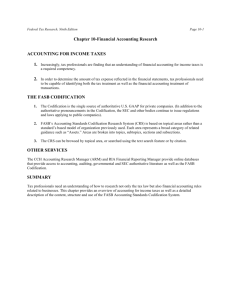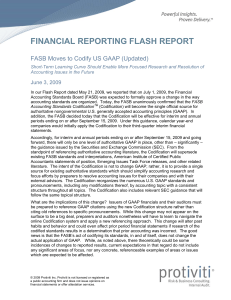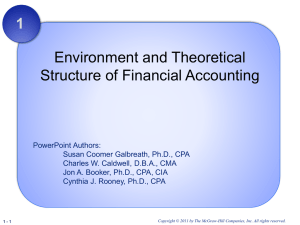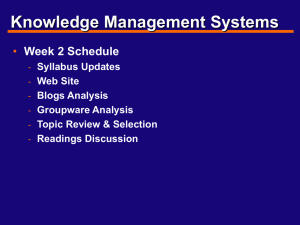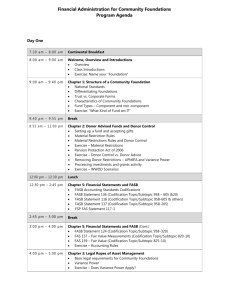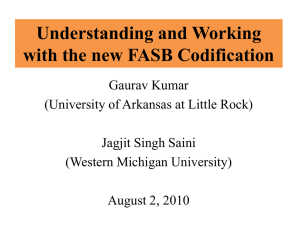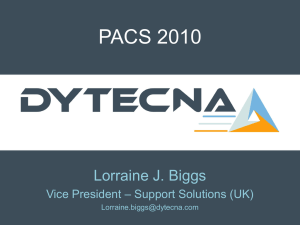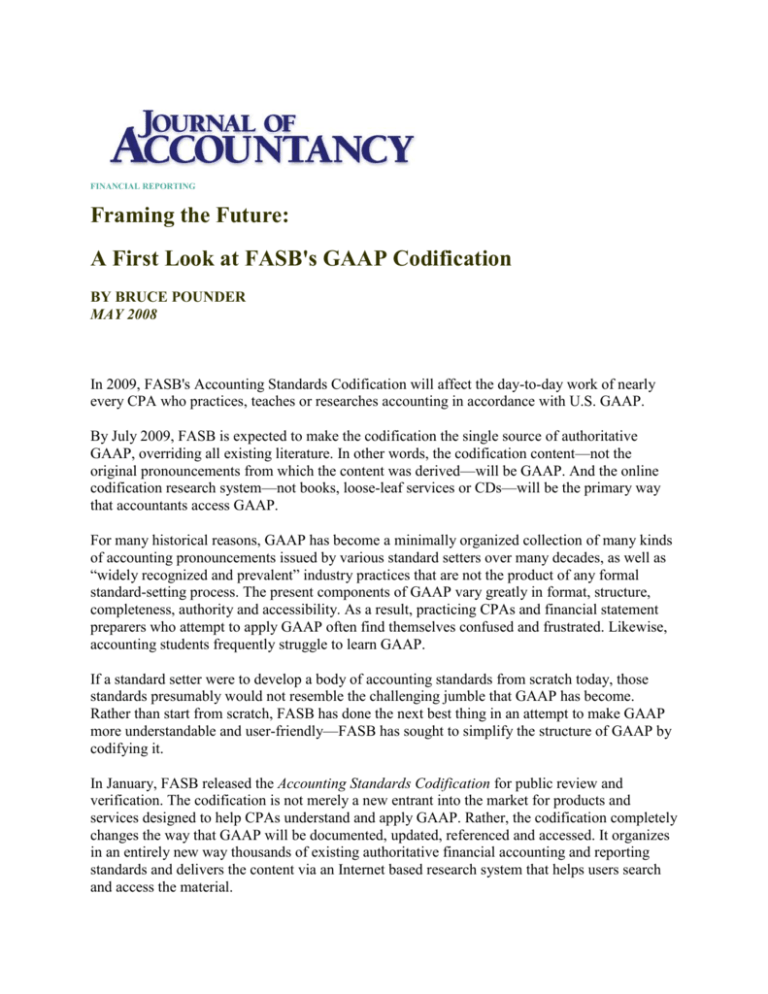
FINANCIAL REPORTING
Framing the Future:
A First Look at FASB's GAAP Codification
BY BRUCE POUNDER
MAY 2008
In 2009, FASB's Accounting Standards Codification will affect the day-to-day work of nearly
every CPA who practices, teaches or researches accounting in accordance with U.S. GAAP.
By July 2009, FASB is expected to make the codification the single source of authoritative
GAAP, overriding all existing literature. In other words, the codification content—not the
original pronouncements from which the content was derived—will be GAAP. And the online
codification research system—not books, loose-leaf services or CDs—will be the primary way
that accountants access GAAP.
For many historical reasons, GAAP has become a minimally organized collection of many kinds
of accounting pronouncements issued by various standard setters over many decades, as well as
“widely recognized and prevalent” industry practices that are not the product of any formal
standard-setting process. The present components of GAAP vary greatly in format, structure,
completeness, authority and accessibility. As a result, practicing CPAs and financial statement
preparers who attempt to apply GAAP often find themselves confused and frustrated. Likewise,
accounting students frequently struggle to learn GAAP.
If a standard setter were to develop a body of accounting standards from scratch today, those
standards presumably would not resemble the challenging jumble that GAAP has become.
Rather than start from scratch, FASB has done the next best thing in an attempt to make GAAP
more understandable and user-friendly—FASB has sought to simplify the structure of GAAP by
codifying it.
In January, FASB released the Accounting Standards Codification for public review and
verification. The codification is not merely a new entrant into the market for products and
services designed to help CPAs understand and apply GAAP. Rather, the codification completely
changes the way that GAAP will be documented, updated, referenced and accessed. It organizes
in an entirely new way thousands of existing authoritative financial accounting and reporting
standards and delivers the content via an Internet based research system that helps users search
and access the material.
One often–overlooked aspect of the codification is that it will eliminate or flatten the GAAP
hierarchy. In other words, there will be no more House of GAAP—no tiered structure with
varying levels of authority on each floor. Under the codification, there’s no distinction—all
standards are uniformly authoritative.
FASB expects that the codification will help mitigate the risk of noncompliance with accounting
standards, provide real time updates as standards change and reduce the amount of time and
effort required to research accounting issues.
A MAJOR RESTRUCTURING
The primary goal of the codification project is not to change GAAP’s content, but rather to
organize it in a more useful way. The codification will contain all current, authoritative
accounting standards for nongovernmental entities that have been issued by U.S. standard setters,
including FASB, FASB’s Emerging Issues Task Force (EITF), and the AICPA Accounting
Standards Executive Committee (AcSEC). Certain SEC guidance also is included.
The codification has, for the most part, left standards unchanged. Appendix A of the Notice to
Constituents , an overview document on the codification Web site, highlights areas in which
FASB is recommending changes to standards to resolve conflicts in GAAP.
As used above, the word “authoritative” refers to GAAP from levels A through D in the current
GAAP hierarchy. Undocumented industry practices and documented but-nonauthoritative
guidance have been excluded from the codification. Because there are some exceptions regarding
what is included in the codification, users are advised to consult FASB’s Notice to Constituents .
The project effectively disassembled each existing authoritative pronouncement and reassembled
the pieces, organizing them into approximately 90 topics. Contents in each topic are further
organized first by subtopic, then section and finally paragraph. The paragraph level is the only
level that contains substantive content; all higher levels in the topical structure exist merely to
organize the paragraph-level content.
A number is assigned to specific content at each level. Citing particular content in the
codification simply involves specifying the unique numeric path to the content through the topic,
subtopic, section and paragraph structure. The conceptual organizational structure and citation
scheme are summarized in Exhibit 1.
This approach organizes the codification content without regard to the original standard setter or
standard from which the content was derived. Once the codification is officially adopted by
FASB, citations of standards such as Statement of Financial Accounting Standards no. 133 will
no longer be used because such standards will no longer be considered authoritative GAAP.
References to standards will consist solely of the numbers used in the codification’s structural
organization.
“One thing I’ve observed is for people that are very used to the standards and quoting chapter
and verse out of particular paragraphs, this is almost like learning a foreign language for
them…,” Jay Hanson, national director of accounting for McGladrey & Pullen LLP and an
Emerging Issues Task Force member, said during FASB’s March 13 webcast on the codification.
CPAs who serve public companies and others with SEC reporting requirements should note that
FASB plans to make relevant SEC guidance on accounting and financial reporting available
through the codification, although such guidance will not be considered authoritative GAAP. The
SEC guidance in the codification will be provided strictly on a convenience basis, and FASB has
made extensive disclaimers regarding reliance on it.
Going forward, only FASB will issue authoritative accounting standards. Only one type of
standard will be issued, and all standards will be numbered sequentially within each calendar
year. The standards themselves will not be authoritative but will specify how the authoritative
codification is to be updated.
THE RESEARCH SYSTEM
The codification’s online research system at http://asc.fasb.org is the primary means through
which FASB will provide access to the codification’s content. During the public verification
period, the online research system will be the only way to access the codification content.
Access to the research system during the verification period is free to those who register.
Tutorials are available to help new registrants learn to use the system. Financial Accounting
Foundation (FAF) trustees, who oversee FASB, have not decided whether to charge for access
after the codification is formally adopted.
Users can browse codification content directly via an outline structure that reflects the content’s
organizational layers or perform advanced keyword searches to find specific content. Searching
by specific citation is also an option. Content can be copied and pasted, printed and/or e-mailed.
A cross-reference feature (see screensho) reconciles specific codification content back to its
source, that is, the pronouncements from which it was derived.
SO YOU THINK YOU KNOW GAAP? THE VERIFICATION PERIOD
Within five weeks of the Jan. 15 start of the verification period, more than 10,000 people had
registered to use the online research system. Registered users can submit comments through a
customized electronic feedback feature. “We’re encouraging all our members to take the time to
use the codification in the course of their daily work during the verification period and offer their
feedback to FASB,” AICPA President and CEO Barry Melancon said in a press release about the
project.
FASB officials are encouraging users to submit feedback if they believe the codification fails to
accurately reflect existing GAAP. The verification isn’t a vehicle for expressing opinions on
current standards if the standards are reflected accurately in the codification. Keep in mind that
the codification doesn’t reproduce current literature word for word or include text that is not
essential to the standards. Users should look for any substantive technical changes that may have
been introduced inadvertently into the codified standards as a result of the editorial practices that
are explained in FASB’s Notice to Constituents posted on the codification Web site.
To complete its work on time, FASB’s codification team did not include standards issued after
June 1, 2007, with one exception, Statement no. 141(R), Business Combinations. Those newer
standards will be processed as “Codification Update Instructions” during the verification period.
Because the codification is a work in progress, users should visit the “What’s New” section of
the site regularly during the verification period to see what FASB has changed or added.
HOW THE CODIFICATION WILL AFFECT CPAs
Because the codification will profoundly change the way GAAP is documented, updated,
referenced and accessed, CPAs, preparers and users of financial statements will need to learn
how to effectively use the codification. With FASB’s target date for officially adopting the
codification less than a year away, now is the time to begin preparing.
Specifically, CPAs will need to become familiar with the codification content and online
research system to identify and cite authoritative GAAP when documenting support for
preparers’ decisions regarding accounting policy, discussing accounting policies with audit
clients and conducting general accounting research.
To provide resources for accountants and auditors, the AICPA will continue to develop industry
specific accounting and auditing guidance and will update its professional literature, including
the Audit and Accounting Guides, to reflect the codification, according to Arleen Thomas,
AICPA senior vice president–member competency and development.
Marc Simon, a senior manager at BDO Seidman LLP, was among the codification research
system’s early registered users. He says the system could help CPAs better integrate Emerging
Issues Task Force guidance into their research of an accounting issue. “EITF issues are one of
the toughest parts of research,” says Simon. “Because the EITF guidance will be integrated with
all other guidance in the codification, CPAs who use the codification for research can be more
confident that they haven’t missed something important.”
Because the planned April 2009 adoption of the codification as authoritative GAAP will coincide
with the end of busy season for many CPAs, BDO Seidman plans to conduct firmwide training
on the codification later this year and in early 2009, says Simon.
RETOOLING GAAP EDUCATION
The codification will dramatically alter accounting education in the United States, both at the
college level and in continuing professional education. Every textbook, PowerPoint presentation,
classroom lecture and self-study CPE program that references GAAP will need to be updated.
The impact of the codification’s research system on the Uniform CPA Examination cannot be
overlooked, especially for research questions that require exam-takers to search authoritative
literature.
GAAP’s reorganized content could present challenges for providers of research products and
services aimed at the CPA profession. FASB board member Lawrence Smith said during a
March 13 webcast that FASB plans to publish a print version of the codification content after
the codification becomes authoritative. Because the codification research system is likely to
initially enjoy a substantial competitive advantage in the market for such products and services,
CPAs may find themselves and their firms rethinking their purchasing decisions. BDO’s Marc
Simon says he’ll be watching how third-party providers of research tools respond to the
codification, and he notes that such tools could still add value if they incorporate nonauthoritative content such as the “Basis for Conclusions” found in existing and future standards.
CPAs should also recognize that the codification is part of a bigger picture. It bolsters other
initiatives to simplify accounting and financial reporting in the United States. Those initiatives
include the activities of the SEC’s Advisory Committee on Improvements to Financial
Reporting. See the committee’s Web page at http://www.sec.gov/about/offices/oca/acifr.shtml
for details of the committee’s recommendations, especially with regard to financial reporting
standards and the standard-setting process.
The committee has proposed, for example, that industry-specific guidance that conflicts with
“generalized GAAP” be removed or minimized. Because the codification places industryspecific standards in topics separate from more-general standards, it would be relatively easy for
FASB to drop industry-specific standards from GAAP.
FASB intentionally organized the codification content to closely mirror the structure of
International Financial Reporting Standards. That alignment will facilitate the ongoing
comparison, convergence and mutual improvements to the two sets of standards.
The codification also comes at a time of growing use of XBRL technology for electronic
financial reporting. The codification will help keep the newly developed GAAP XBRL
taxonomies in sync with GAAP itself.
AICPA RESOURCES
JofA articles
“Change Agent,” Feb. 08, page 30
“A Future That Matters,” Feb. 06, page 35
Webcast
The AICPA’s free May 15 webcast on the GAAP codification (#WBC08044I for individuals or
#WBC08044C for corporate/group viewers). Participants can earn one CPE credit.
For more information or to make a purchase, go to www.cpa2biz.com or call the Institute at 888777-7077.
The AICPA will offer self-study CPE courses to help CPAs understand the new codification and
become familiar with its structure to effectively begin researching issues using the codification.
Information will be available soon at www.cpa2biz.com regarding these resources and other
offerings coming this fall.
OTHER RESOURCES
Web sites
FASB’s Accounting Standards Codification, http://asc.fasb.org
FASB's Notice to Constituents, http://asc.fasb.org/imageRoot/73/2334073.pdf
Webcast
FASB’s archived March 13 webcast “The Move to Codification of U.S. GAAP,”
www.fasb.org/fasb_webcast_series/03-13-08_fasb_webcast.shtml
EXECUTIVE SUMMARY
FASB's Accounting Standards Codification consists of topically organized content that
will soon become the single authoritative source of GAAP as well as an online research system
that will be the primary means of accessing the content.
CPAs who refer to GAAP in their work should begin familiarizing themselves with the
codification now because it will profoundly change the way GAAP is documented, updated,
referenced and accessed in the near future.
The codification leaves standards mostly unchanged. Appendix A of FASB’s Notice to
Constituents highlights areas where FASB is recommending changes to standards to resolve
conflicts in GAAP.
The codification organizes standards into approximately 90 topics. Contents in each
topic are further organized first by subtopic, then section and finally paragraph. The paragraph
level is the only level that contains substantive content; all higher levels in the topical structure
exist merely to organize the paragraph level content. A number is assigned to specific content at
each level.
Until January 2009 CPAs will have the opportunity to review the codification and provide
feedback on it to FASB. Codification users should look for substantive technical changes that
may have been introduced inadvertently into the codified standards as a result of wording FASB
modified to improve the flow of the codification.
Bruce Pounder MBA, CMA, CFM, is president of Leveraged Logic in Asheville, N.C. His e-mail
address is bpounder@LeveragedLogic.com.
Copyright © 2008 American Institute of Certified Public Accountants. All rights reserved.

